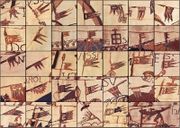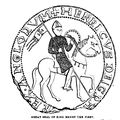Banners
| Banners |
|---|
|
More Weapons pages
Banners, standards, flags, gonfanon (guntfano) and pennons (pennants) were commonly adopted by the warriors of the 9th – 12th centuries. This article attempts to briefly outline what the authors currently know about the subject.
The style of banner stays surprisingly consistent from the 9th to the 12th centuries and across Western Europe. For this reason we’ve decided to look at all the evidence together rather than, as we usually do, break the evidence into English, Carolingian, etc.
From Art
Pennons
These are triangular flags or streamers.
- Banner BL Cotton Caligula A XV f123r
c.1073AD English
BL Cotton Caligula A XV f123r
Banners
These are rectangular flags ending in ‘swallowtails’.
Before 1066AD
The Bayeux Tapestry
After 1066AD
From Literature
Bede – Ecclesiastical History of the English People, 731AD
|
"His [King Edwin] dignity was so great throughout his dominions, that not only were his banners borne before him in battle, but even in time of peace,
when he rode about his cities, townships, or provinces, with his thegns, the standard-bearer was always wont to go before him. Also, when he walked anywhere along the streets, that sort of banner which the Romans call Tufa, and the English, Thuuf, was in like manner borne before him. |
|
[Project Gutenberg 2011] |
|
"...that there might be a perpetual memorial of the royal character of this holy man [King Oswald], they hung up over the monument his banner of gold and purple." |
|
Osthryth, queen of the Mercians [Project Gutenberg 2011] |
Capitulary of Charles the Bald, 843-877AD
|
“Let our envoys (missi nostril) see that the troops of every bishop, abbot, and abbess, march forth properly equipped, and with their Gonfalonier (cum Guntfannonario).” |
|
[Hewitt 1885: p.166] |
Beowulf, c.1000AD
|
"High o'er his head they hoist the standard, |
|
[Fordham.edu] |
|
"To Beowulf gave the bairn of Healfdene |
|
[Fordham.edu] |
|
"His glance too fell on a gold-wove banner |
|
[Fordham.edu] |
Master Wace, The Chronicle of the Norman Conquest (Roman de Rou), c.1174
|
“When Harold had made all ready, and given his orders, he came into the midst of the English, and dismounted by the side of the standard, Leofwin and Gurth, his brothers, were with him; and around him he had barons enough, as he stood by his gonfanon, which was in truth a noble one, sparkling with gold and precious stones. After the victory William sent it to the apostle, to prove and commemorate his great conquest and glory.” |
|
[PICKERING 1837] |
|
“L’apostoile li otreia, un gonfanon li enveia, un gonfanon et un anel, mult precios e riche e bel; si come it dit, desoz la pierre, aveit un des cheveuls Saint Pierre” |
|
Line 11,450 [MICHEL 1836: p.147] Charlemagne: An Anglo-Norman Poem of the Twelfth Century edited by Francisque Michel 1836 |
Late Roman Draco Standards
Art
Literature
|
"Hic arripiens signum quod apud eo habebatur sacrum, leonis atque draconis desuper aquilae volantis insignitum effigie ..." |
|
About Witikind, an adversary of Charlemagne. [Oakshott 1963:p178] |
Archaeology
--
Discussion
"... be the end would have been different. But Harold was struck, and cut down by a Norman sword when William's knights burst through the Huscarles to trample down the Dragon standard and Harold's banner of the Fighting Man." [Oakshott 1963:p.180]



